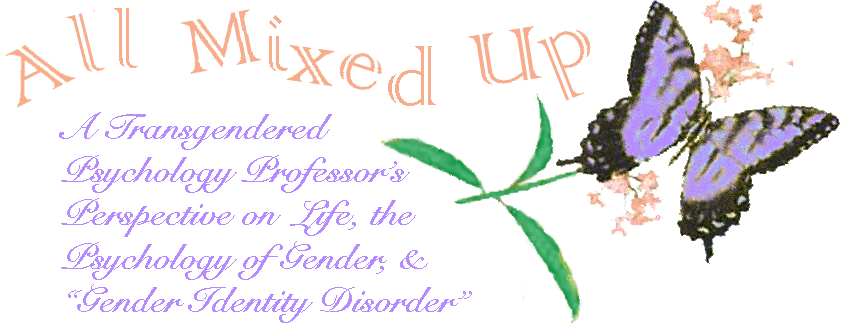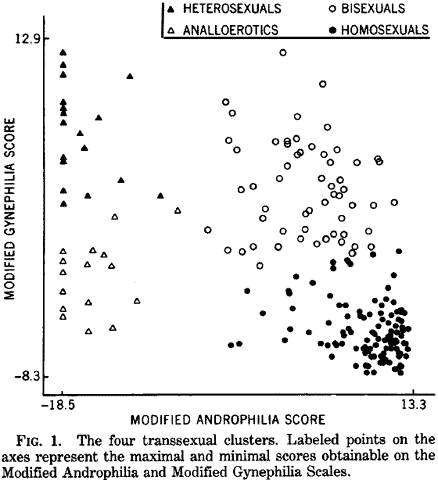
|
|

|
Read the method to Ray Blanchard's (1989) paper "The concept of autogynephilia and the typology of male gender dysphoria."
This is page 1 (above links) & 8 (below links) of 9. [1] [2] [3] [4] [5] [6] [7] [8]
The on-line database of the Clarke Institute of Psychiatry's Research Section of Behavioural Sexology includes questionnaire data on 2700 male patients who have presented either at the department or at the Institute's gender Identity Clinic since September 1980 - the date when the last questionnaire items used in this study were added to the test battery. These cases were searched for all subjects who endorsed one of the first three options of the following questionnaire item:
Have you ever felt like a woman?
a) Only if you were wearing at least one piece of female underwear or clothing
b) While wearing at least one piece of female underwear or clothing and only occasionally at other times as well
c) At all times for at least 1 year
d) Never felt like a woman.
This questionnaire item is only administered to patients complaining of gender dysphoria or transvestism, who reveal cross-dressing or cross-gender wishes in the course of clinical assessment, or who exhibit an erotic preference for males of any age regardless of presenting complaint. Therefore, subjects who met the formal entrance criterion actually came from a clinically preselected subset of the database,
A total of 302 cases was retrieve for this study. These cases will be referred to as the full sample. The number who endorse option a of the criterion item was 31; option b, 59; and option c, 212. As in previous studies using this database (Blanchard, 1985b, 1988b; Fruend et al., 1982), those cases who endorsed option c will be designated the transsexual group.
The mean age of the full sample was 30.7 years (range = 17 to 67 years(, and that of the transsexual group was 30.3 (range - 17 to 63 years). The median education of both groups was grade 12.
A cluster analysis was used to divide the transsexuals into analloerotic, bisexual, heterosexual, and homosexual groups. It must be emphasized that the cluster analysis was not performed to discover or to confirm the existence of clusters among the transsexual subjects. It was chosen as a convenient and relatively non-arbitrary way of assigning subjects to a set of predetermined groups.
The cluster analysis was carried out on the 212 transsexual subjects only. An interative partitioning method, the BMDP K-means clustering program (Engleman and Hartigan, 1981), was used. Input variables were subjects' scores on the Modified Androphilia and Modified Gynephilia Scales (Blanchard, 1985b), measures of erotic attraction to physically mature males and females respectively. These scales, which were specifically developed for the assessment of adult male gender patients, were standardized to unit variance for this procedure.
The analysis was predetermined to yield four clusters. The initial partition of cases was "seeded" with cluster centroids representing idealized score profiles for the four transsexual types. [Footnote 1: The heterosexual cluster, for example, was seeded with the values 12.9 (the highest possible Modified Gynephilia score) and -18.5 (the lowest possible Modified Androphilia score). In geometric terms, the seed points correspond to the four corners of Figure 1.]. As expected, seeding the clusters forced the cluster analysis to produce four groups that could readily be identified as analloerotic, bisexual, heterosexual, and homosexual. This analysis assigned 18 cases to the analloerotic cluster, 58 to the bisexual cluster, 19 to the heterosexual cluster, and 117 to the homosexual cluster.

All questionnaire materials used in the present investigation are embedded within Kurt Fruend's unpublished Erotic Preference Examination Scheme, relevant sections of which are routinely administered to male patients in the two departments to which the subjects had been referred. The materials included previously developed questionnaire scales as well as the item pool selected for the present investigation.
Four previously developed self-report scales were used in this study. These included the Modified Androphilia and Gynephilia Scales as well as two measures used as dependent variables. The Cross-Gender Fetishism Scale (Blanchard, 1985a, 1988a) is a measure (for males) of the erotic arousal value of putting on women's clothes, perfume, and make-up, and shaving the legs. The Heterosexual Experience Scale (Freund and Blanchard, 1988) is intended to assess sexual experience with women, as opposed to sexual interest in them. The present study used a slightly modified version of this scale, which deleted the last item.
The Erotic Preferences Examination Scheme includes a variety of items that do not belong to any of its developed scales. These have been added at various times in the general hope that they might prove useful in future research, not always with a specific future scale in mind. A pool of 16 items was selected from these for investigation in the present study. Two different types were selected: a) Items concerning sexual arousal in connection with cross-gender ideation, and b) items concerning sexual attraction vs. sexual indifference towards other persons. The latter were included in the pool because of Hirschfeld's (1918) impression that autogynephilia interferes with normal heterosexual attraction. Only one item was discarded after statistical analysis; the remaining 15 are presented in the Appendix.
This is page 1 (above links) & 8 (below links) of 9. [1] [2] [3] [4] [5] [6] [7] [8]
|
|
|